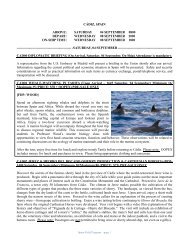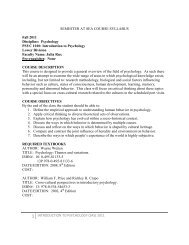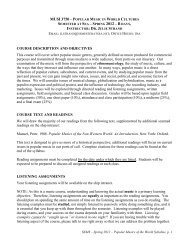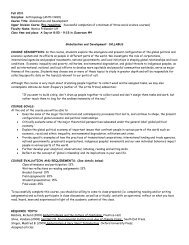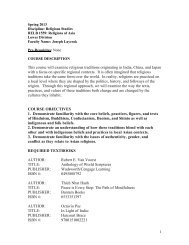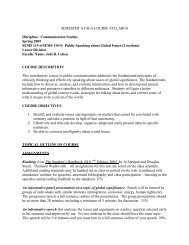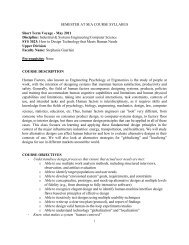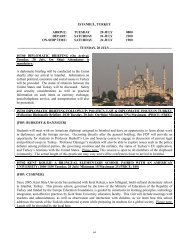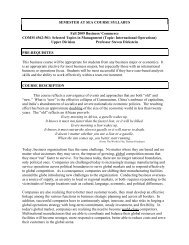ANTH 3559 - University of Virginia
ANTH 3559 - University of Virginia
ANTH 3559 - University of Virginia
Create successful ePaper yourself
Turn your PDF publications into a flip-book with our unique Google optimized e-Paper software.
Read: -Schluter “Heritage Tourism in Latin America: Can Turbulent Times be Overcome?”<br />
-J. Ingram “Volunteer Tourism: How Do We Know It is Making A Difference?”<br />
-Any Latin America or Caribbean country chapter in Robert Young Pelton’s Fielding’s<br />
The World’s Most Dangerous Places (1998) Redondo Beach, Calif.: Fielding<br />
Worldwide Inc. Pp. 349-369. (skim for a feel for the writing and imagery).<br />
Optional Readings & Resources:<br />
-Adams, Kathleen “Danger Zone Tourism: Prospects and Problems for Tourism in<br />
Tumultuous Times” in Worlds: Tourism in Southeast Asia. (2001). Pergamon Press.<br />
-Goodwin, H. “Ch. 5: Measuring and Reporting the Impact <strong>of</strong> Tourism on Poverty” in<br />
Developments in Tourism Research, ed. By Tribe and Airey (2007), Elsevier Ltd.<br />
-Phipps, Peter “Tourists, Terrorists, Death and Value” in R. Kaur and J. Hutnyk (eds.)<br />
Travel Worlds: Journeys in Contemporary Cultural Politics. (1999) Zed Books.<br />
-“Dark Tourism” web site: http://www.dark-tourism.org.uk/<br />
-J. Lennon & M. Foley Dark Tourism (2000) London: Continuum.<br />
-Mowforth, Charlton, & Munt “Ch 6: Urban Tourism: The Heart <strong>of</strong> Darkness?” in Tourism<br />
and Responsibility.<br />
-Wearing and Ponting “Breaking Down the System: How Volunteer Tourism Contributes<br />
to New Ways <strong>of</strong> Viewing Commodified Tourism” in Tazim Jamal & mike Robinson Sage<br />
Handbook <strong>of</strong> Tourism Studies (2009), London: Sage.<br />
-In class video segment from “Can’t Do It In Europe”<br />
Day 5: Part A: Midterm Quiz; Part B: Analyzing Tourism: Methods, Sites, Verbal and<br />
Material Products <strong>of</strong> Tourism<br />
A. Midterm Quiz<br />
B. Analyzing Tourism Narratives, Verbal Representations, Brochures & Travel Trinkets<br />
How do narratives (guides’ verbal presentations about sites, museum labels etc) construct what<br />
the tourist sees and experiences? And what <strong>of</strong> tourists’ narratives about their trips? How do<br />
travel stories contribute to the shaping <strong>of</strong> others’ perceptions <strong>of</strong> destinations and the peoples<br />
residing in those destinations? To the shaping <strong>of</strong> their own identities? Research methods in<br />
tourist sites, narrative analysis, etc. What is the role <strong>of</strong> material culture in defining tourist<br />
destinations? How are tourist arts & tourist desires linked? Tourism, photography and the<br />
meandering gaze, Case study <strong>of</strong> Panama’s Cuna molas (& the economic empowerment <strong>of</strong> ethnic<br />
minorities and indigenous women).<br />
Read: Ylanne-McEwen “Golden Times for Golden Agers: Selling Holidays as Lifestyle<br />
for the Over 50s” (2000, Summer) Journal <strong>of</strong> Communication 50(3):83-99 (Read this<br />
article as an example <strong>of</strong> how to do textual analysis <strong>of</strong> travel agent dialogues with<br />
potential customers. If pressed for time, you can skim some <strong>of</strong> the examples, but be sure<br />
to grasp their methodology and findings). (In course folder)<br />
IMPORTANT: Bring to class: Write a brief 1 to 2 paragraph auto-ethnography on a<br />
photo you have taken or a souvenir you have bought (or, if you prefer, interview a friend<br />
about a souvenir they bought). If possible, bring the souvenir to class. (This will partially<br />
contribute to your participation grade)<br />
5



